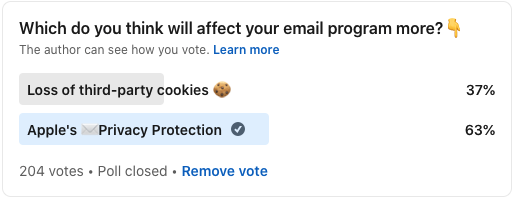Consumer privacy protection is a huge trend imparting marketing as a whole—and email marketing specifically in the coming months.
With Apple Mail Privacy Protection rolling out in September, how we “do email” is changing. We need to prepare for a season of flying blind and identify new ways to measure email performance.
In the second part of our Ultimate Email Summit online event, Jessica Raggio (VP of Product Marketing at Litmus), John Billington (Director of Product Management at Litmus), and I share practical tips to help you prepare for the future of email insights and analytics.
Didn’t make the live webinar? That’s OK. We recorded the whole thing. Watch the recording here, or read the recap below:
What privacy changes are happening?
In the live webinar, we addressed two big changes that will impact marketing: Apple Mail Privacy Protection and the end of third-party cookies.
Third-party (3P) cookies are text files that store data about web experiences across different websites, and help inform companies about the people who visit their own websites. While this will impact demand generation teams more, the end of 3P cookies is going to mean a focus on first-party data—and email is a key driver of this.
Mail Privacy Protection (MPP) stops senders from collecting certain email data about Apple Mail users. It prevents senders from knowing if and when they open an email. And it masks their IP address so it can’t be linked to other online activity or used to determine their location. It also hides their device information so you can’t tell if the subscriber is using an iPhone or a Mac.
This matters because you won’t be able to tell who opened your emails and when via Apple Mail. And because Apple’s caching servers will inflate the counts of total opens and make it very difficult to get an accurate open rate.
We asked you all which you see having a bigger impact, and the answer was clear: Mail Privacy Protection all the way.
Despite the impending changes to email, we don’t believe that email is dead. We’ve gone through changes before (looking at you, GDPR, CASL, and CCPA), and we’ll do it again.
With that in mind, we talked about how MPP will impact email marketers and some practical steps to prepare in the coming months. Sharing them with you here now.
6 tips to prepare for Mail Privacy Protection
While there are still a lot of unknowns, there are ways we can start to take action based on what we do know.
1. Update re-engagement campaigns
To start, look at what’s triggering these campaigns. Often, re-engagement campaigns rely heavily on open rate data. Here at Litmus, we’re redefining re-engagement for our own lists using opens and clicks. Why keep opens in there? Because not every email has a call-to-action that requires a click. That, and not everyone uses Apple Mail! So, for the time being, we’re keeping opens as part of our engagement criteria.
Then, look at how your emails are worded. Are you saying things like, “You haven’t opened our emails in a while”? Change the verbiage to reflect low engagement, but not opens specifically.
2. Send a reconfirmation campaign
Reconfirmation campaigns allow subscribers to continue to opt into your emails—or opt out. Since we can no longer rely solely on opens to clean our lists, this helps you maintain list hygiene and deliverability. A bonus here is you get explicit opt-in to email these folks. So while that’s not required across the board, it might be in the future. Better to have that explicit opt-in, yeah?
Word to the wise: Consider sending your reconfirmation campaign more than once to people who didn’t re-confirm, as people may not see your email for a variety of reasons. You can also use other metrics, like website activity or interaction with another email, to understand if they’re still engaging with you in some capacity.
3. Create a reliable opens audience
Do you know the extent to which MPP will impact you? You can measure the impact of this coming change in email performance measurement by segmenting your audience by email client device. Not only will this help you understand the scope of impact, but it will also set you up to approximate email engagement in the future.
Some email service providers (ESPs) can help you determine this segmentation by email client, but if yours doesn’t provide email client open data, you can use Litmus Email Analytics to get this breakdown.
Device identification analytics can help you create an audience segment known to be using non-Apple email clients—and this segment will continue to provide accurate open data after the roll out of MPP this fall. (Read more on how to create a reliable opens audience using non-Apple email clients.)
In addition to using this list as an opens proxy, consider this: Is the read time for Apple device subscribers similar? If so, you’ll be able to use the Gmail and Outlook read time, for example, as a proxy for read time of your emails going forward.
4. Broaden engagement metrics
With all the changes hitting marketing as a whole, it’s more important than ever to break down data silos in marketing.
In addition to email-specific metrics, consider incorporating cross-channel metrics that show customer engagement, like purchases, account activity, website visits, and SMS engagement. This will especially be important for newsletters and retention-related emails where you may be more focused on getting the subscriber to read instead of buy. These cross-channel metrics can help you better identify who’s engaged and to what extent.
5. Promote preference center updates
Give your subscribers an opportunity to tell you what they want to receive from you and how frequently they want to hear from you.
If you already have a preference center that offers the ability to indicate a preference on email frequency, promote it more aggressively during signup and periodically during the email relationship. If you don’t currently offer this, consider adding it as a way to improve subscriber engagement by meeting their expectations.
6. Start tracking Email Quality Score
This is a concept Lucas Chevillard shared on the Really Good Emails podcast (which you should totally subscribe to if you haven’t already). At its core, it shows you how many people are annoyed by your messages vs. actually enjoy receiving them.
The formula for Email Quality Score is simple: Unsubscribers divided by Responders (responders could be measured by unique clicks) removed from 1 and then multiplied by 100.
This can help you understand engagement quality and should be combined with clicks and unsubscribes. (Insider insight: We’re planning to include this metric or something similar in our Integrated Insights Report in the fall.)
We’ve got your back!
When it comes to preparing for the future of email insights and analytics, we’ve got you covered. Check out our recent blogs on the topic:
- Holistic Email Metrics Matrix: Are You Seeing the Whole Picture?
- How to Create a Reliable Opens Audience for Non-Apple Mail Users
- Identifying ‘Real Opens’ Is Key to Adapting to Apple’s Mail Privacy Protection
- 5 Tips to Prepare Your Email Program for Mail Privacy Protection (and Still Be Successful)
- Apple’s Mail Privacy Protection: What This Means for Email Marketers and How to Prepare Now
The post Prepare for the Future of Email Insights and Analytics: Webinar Recording + Takeaways appeared first on Litmus.
![]()

